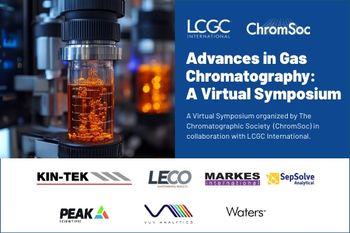
- LCGC North America-05-01-2007
- Volume 25
- Issue 5
Solid-Phase Extraction pipette Tip Sample Preparation for Membrane Protein Intact Mass Analysis by MALDI–MS
Analysis by mass spectrometry (MS) of integral membrane proteins and those associated with membrane is an important aspect of proteomics.
Studying membrane proteins is important in proteomics research. Matrix-assisted laser desorption ionization time-of-flight mass spectrometry (MALDI-TOF–MS) is recognized widely as a valuable tool in the proteomics field (1–3). Membrane proteins, however, are very difficult to work with due to their limited solubility in aqueous solvent. The challenge of applying MALDI–MS to such hydrophobic proteins is solvating the proteins in a solution that is compatible with MALDI, while simultaneously avoiding ion suppression of the MALDI response by the salts and detergents used for the solubilization of membrane proteins (4–6). Solid-phase extraction (SPE) pipette tips packed with hydrophobic media are commercially available devices that can desalt, remove detergents, and concentrate proteins and peptides effectively before mass analysis (7–9). Because membrane proteins have very limited aqueous solubility, the elution solution has to be tailored for this application. Our method utilizes the strategy of solubilizing the hydrophobic proteins with concentrated formic acid (7) and organic solvent.
Experiments
An unknown hydrophobic protein was analyzed (molecular weight around 37,000) by using this method because its intact mass spectrum could not be acquired by routine protocol. The protein was expressed in E.coli BL21 (DE3) strain in insoluble part. It was extracted by using buffer containing the nonionic detergent dodecylmaltoside (0.05% v/v) and purified using ion-exchange chromatography with a 0–100% 0.5 M sodium chloride gradient. The final form of the purified protein (24 μM) that was submitted to mass analysis was in 0.2 M sodium chloride, 50 mM tribasic sodium phosphate, and 0.05% (v/v) dodecylmaltoside solution. A ZipTipC4 SPE pipette tip (Millipore, Billerica, Massachusetts) technique was applied as follows: 18 μL of protein sample was acidified with 2 μL of 20% trifluoroacetic acid and was then mixed with 2 μL of 120 μM myoglobin as an internal standard. The MALDI matrix α-cyano-4-hydroxycinnamic acid (Bruker Daltonics, Billerica, Massachusetts) was prepared in 3:1:2 (v/v/v) formic acid–water–isopropyl alcohol (5). The matrix mixture was centrifuged before use. Before binding the protein sample to the SPE pipette tip, the tip was wetted twice each with 10 μL 50% acetonitrile in 0.1% trifluoroacetic acid and equilibrated twice each with 10 μL 0.1% trifluoroacetic acid. To properly bind proteins to the SPE pipette tip, the sample solution was aspirated and dispensed about 10 times through the tip and then washed twice with 0.1% trifluoroacetic acid. The protein was eluted with 3 μL of 40:60 formic acid–isopropyl alcohol, a condition significantly different from conventional elution solution. To achieve maximum sensitivity, one must carefully aspirate and dispense the tip with the elution solutions 10 times. The eluted sample was mixed with previously prepared matrix solution in a 1:9 ratio before spotting on a MALDI plate. The total amount of the sample spotted on the target plate was about 3 pmol.
Figure 1 is a mass spectrum acquired using a MALDI-TOF–MS Reflex IV mass spectrometer (Bruker Daltonics) operated in a linear, delayed-pulse ion-extraction mode. Proteins were desorbed and ionized by a pulsed nitrogen laser with a 337-nm wavelength. Each high-quality mass spectrum was summed in a buffer. A final spectrum was saved and then edited and analyzed using Xmass software (Bruker Daltonics). Internal calibration was carried out using singly and doubly charged ions of myoglobin (peak of 16952.5 and 8476.5, respectively). The molecular weight was determined on the triply charged ion of the membrane protein, because it was bracketed between the internal calibrant peaks. The molecular weight of the hydrophobic protein determined was 37419.6, which later was identified as an outer membrane protein F precursor of Escherichia coli (P02931, data from peptide mass mapping not shown).
Figure 1
Another example of using this concentrated formic acid–isopropyl alcohol SPE pipette tip procedure is the analysis of proteins stored in buffers containing 10% glycerol, which often is used in enzyme purification to improve protein solubility and to avoid freezing in cold rooms. hMYH (Human MutY Homolog, accession NP_036354) is a human DNA N-glycosylase in DNA repair that removes an adenine moiety base-paired with 8-oxoguanine in a sequence mismatch. The molecular weight of human MYH with PKA-Flag-His tags at the C-terminus was 60,505. The protein was partially digested by trypsin to reduce its size and then was solubilized in 10% glycerol. The 10% glycerol had to be removed before the MALDI analysis because it would interfere with the cocrystallization between the target sample and the matrix. A control experiment indicated that the 50% acetonitrile in 0.1% trifluoroacetic acid solution (a commonly used elution solution for the SPE pipette tip) used to elute trypsin-trimmed MYH (TMYH) protein from the SPE pipette tip was unable to elute TMYH from the C4 pipette tip media. However, the protein was eluted by a solution of 40% formic acid and 60% isopropyl alcohol. The procedure is briefly described as follows: 17 μL of TMYH (58 μM) in 40 mM HEPES, 500 mM sodium chloride, and 10% glycerol was mixed with 3 μL of water and 2 μL of 20% trifluoroacetic acid. An SPE pipette tip unit was wetted and equilibrated properly before the sample was applied. TMYH was eluted with 3 μL of 40% formic acid and 60% isopropyl alcohol. The eluted TMYH mixed with matrix solution in a 1:9 ratio and 0.2 μL (6.6 pmol of TMYH) of the mixture was spotted on the MALDI plate. A 0.2-μL volume of a solution containing 1 pmol bovine serum albumin (a 30 μM stock solution prepared as described previously for the TMYH sample; the concentration used was experimentally determined) was spotted onto the TMYH spot as internal standard. The molecular weight of treated MYH was 48748.37 as shown in Figure 2. The singly and doubly charged ions of bovine serum albumin, peaks of 66431.00 and 33216.00, respectively, were used for internal calibration.
Figure 2
Conclusion
There are several important advantages associated with this sample treatment method. It is very simple and no cleaning is required on the MALDI plate after spotting. In contrast, recrystallization on a MALDI plate is a tricky procedure in which the sample is sometimes lost during pipetting.
Some details are important for this concentrated formic acid–isopropyl alcohol SPE pipette tip procedure to be successful. The sample should be analyzed shortly after being prepared to avoid protein formylation. The crystals formed on the MALDI plate might appear to be very faint as though there were no crystals at all. However, upon closer examination, a very thin layer of crystals will be observed. These fine uniform crystals produce reproducible spectra from shot to shot. Finally, the user should choose an appropriate SPE pipette tip based upon the application. C4 material is effective for proteins, and C18 material is better for peptides. Specific information can be found on the selected product manufacturer's website. In conclusion, the concentrated formic acid–isopropyl alcohol SPE pipette tip procedure is a user-friendly method that should help many scientists to produce intact mass spectra successfully with membrane proteins and other hydrophobic proteins and peptides.
Acknowledgment
This project was partially supported by the National Cancer Institute Institutional Core Grant P30CA06927, the Fannie E. Rippel Foundation, Tobacco Settlement Funds from the Commonwealth of Pennsylvania, the Pew Charitable Trust, and the Kresge Foundation. The authors would also like to thank Dr. Hong Cheng and Dr. Yoshihiro Matsumoto for providing samples and technical information of samples in this report.
Yibai Chen and Anthony Yeung
Fox Chase Cancer Center, Philadelphia, Pennsylvania
Please direct correspondence to Yibai Chen at
References
(1) M. Dreger, Mass Spectrom. Rev. 22, 27-56 (2003).
(2) L.E. Ball, J.E. Oatis-JR, K. Dharmasiri, M. Busman, J. Wang, L.B. Cowden, A. Galijatovic, N. Chen, R.K. Crouch, and D.R. Knapp, Protein Sci. 7, 758-764 (1998).
(3) S. Kjellstrom and O. Jensen, Anal. Chem. 75, 2362-2369 (2003).
(4) K.L. Schey, Methods Mol. Biol. 61, 227-230 (1996).
(5) M. Cadene and B. T. Chait, Anal. Chem. 72, 5655-5658 (2000).
(6) J.L. Norris, N.A. Porter, and R.M. Caprioli, Anal. Chem. 75, 6642-6647 (2003).
(7) R. Rachele, L. Ogorzalek, N. Dales, and P.C. Andrews, Methods Mol. Biol. 61, 141-160 (1996).
(8) M.G. Pluskal, Nature Biotechnology, 18, 104-105 (2000).
(9) O. Belgacem, A. Buchacher, K. Pock, D. Josic, C. Sutton, A. Rizzi, and G. Allmaier, J. Mass Spectrom. 37, 1118-1130 (2002).
Articles in this issue
over 18 years ago
Chiral HPLC Columnsover 18 years ago
Validation and Peptide Mappingover 18 years ago
Peaks of Interestover 18 years ago
How Does Temperature Affect Selectivity?over 18 years ago
New Gas Chromatograpy Products at Pittcon 2007Newsletter
Join the global community of analytical scientists who trust LCGC for insights on the latest techniques, trends, and expert solutions in chromatography.





